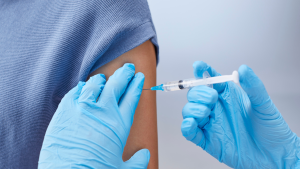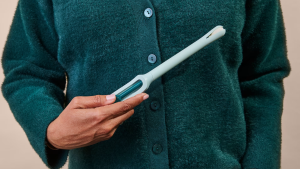How does someone get crabs?
Most cases of crabs happen as a result of intimate contact, when crabs move from the pubic hair of one person to the pubic hair of another. Even when there is no sexual penetration, you can get crabs or give them to someone else if you’re in close physical contact—whenever some part of your body that has coarse hair (such as the pubic area, eyelashes, eyebrows, facial hair, chest, or armpits) comes into contact with the another person’s infested pubic or other course hair. Crabs do not usually attach to head hair.
Crabs can also be passed on in non-sexual ways. For example, it is possible for a person can get crabs from sleeping in an infested bed, using infested towels, or wearing infested clothing. Toilets seats? While not entirely impossible, getting crabs this way would be extremely rare. Not only is the surface of a toilet seat to smooth for crabs to hold on to, but they also don’t live long away from a human body.
What are the symptoms of crabs?
The most noticeable symptom is often intense itching that usually starts about 5 days after a person gets crabs. This itching is caused by an allergic reaction to the bites.
A person may be able to see individual crabs by looking closely or using a magnifying glass. Crabs are small parasites that resemble crabs you see on the beach. They may be whitish-gray or rust colored.
A person may also notice crab eggs—or nits—attached to the base of the hair (close to where it comes out of your body). Nits are small, oval-shaped and pearl-like in color. Dark or bluish spots can appear and last for several days in the infested area; these are also a result of the bites.
Crabs are usually found in the pubic area. However, crabs can also be found in the armpits, eyelashes, beard/mustache and other course hair. Crabs are only very rarely found in the hair on a person’s head.
Crabs, in general, don’t cause anything more than discomfort and inconvenience. Occasionally, secondary bacterial infections may occur due to aggressive scratching.
How are crabs diagnosed?
You can usually see the crabs yourself if you look closely enough. You might need a magnifying glass to help you identify them. If you are uncertain, have a healthcare provider examine you. He or she may need to use a microscope.
How are crabs treated?
Recommended treatments for crabs include:
Permethrin cream
- The cream can be applied to the affected area and washed off after 10 minutes.
- Permethrin is available over the counter.
- Should not be used for treatment of eyelashes or eyebrows.
Lindane shampoo (Kwell®)
- A shampoo that is applied to the affected area and thoroughly washed off after 4 minutes.
- Available only by prescription.
- Should not be used for treatment of eyelashes or eyebrows.
- Should not be used on broken skin.
- Not recommended to be used by the following people:
- women who are pregnant or lactating
- children under 2 years of age
- people with seizure disorders
- people with extensive dermatitis or known allergies to any ingredients found in Lindane
NOTE: Lindane (Kwell®) is potentially harmful and may cause central nervous system complications, even though no problems have been known to occur in treatments limited to the recommended 4-minute period.
Pyrethrins with piperonyl butoxide
- This shampoo is applied to the affected area and washed off after 10 minutes.
- Available over the counter.
- Should not be used for treatment of eyelashes or eyebrows.
For infested eyelids and eyebrows an ointment is available by prescription.
Even if treatment is successful, you may still have some itching as a result of a skin irritation or allergic reaction. If so, you can use hydrocortisone cream to help stop the itching.
What else can I do to get rid of crabs?
- Even after treatment, most nits or eggs will remain attached to the hair. Nits can be removed with fingernails or a fine-tooth comb.
- Wear clean clothing and sleep between freshly laundered bed linens after treatment.
- Notify sex partners so that they can be treated.
- Abstain from sex until treatment is successful and all partners have been treated.
- After you are treated, your clothes and bedding may still be infested with crabs. To get rid of them, you will want to wash all your clothes, bed linens, sleeping bags, etc. in hot water (at least 130 degrees F). Dry on hot cycle for at least 20 minutes.
- Items that cannot be washed can be placed in a plastic bag for two weeks or dry-cleaned to ensure decontamination.
- It is not necessary to decontaminate furniture or fumigate living areas. If desired, furniture can be vacuumed or treated with a bug spray containing an agent active against crabs.
- If after about a week you still see lice, do the treatment again. Make sure that all bedding and clothing have been washed and dried on a hot cycle, dry-cleaned or decontaminated in a plastic bag for two weeks. Also make sure that that sex partners have been treated.
- Contact your healthcare provider if treatment still does not work.
How do I tell my partner I’ve been diagnosed?
If you find out you have crabs, it is important that you talk to your partner or partners as soon as you can so they can get treatment. It is possible to pass crabs back and forth. If you get treated and your partner doesn’t, you may get infected again.







